There is not a more task specific turkey call than the long box. Also known as the paddle box, this type of box call was designed to locate turkeys, pure and simple. It is true, you can soft yelp and cluck on some paddle boxes but they will shine the most when making the music they were designed for – loud, high pitch yelps and aggressive (often offensive) cutts and cackles. If there was ever a ‘boss’ hen, she would sound like this, her image complete with rolling pin, ready to clobber the boss gobbler if he does not answer… and come running in fast.
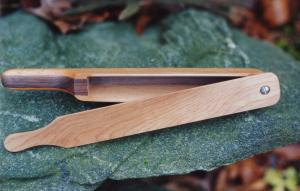
Camp Callers Screamin Hen
Calls from the paddle box ride the border between shock locator and sweet hen sounds. But they do their job well by making turkeys gobble when other calls fail. On windy days, across expansive prairies or humid swamps, through wooded hollows and over high hills, when you want to reach out a little farther, try the long box.
Long Boxes of quality are highly collectable. Some call makers prefer to concentrate their efforts on this specific call. To design and construct consistently good sounding long boxes is not an easy task. So when a truly functional design is accomplished, the formula is often not shared. Even when this information is shared, a high degree of personal determination to fine tune the long box is required before a superior product emerges. Fine tuning involves scraping with a pocket knife, blade held perpendicular to the inside surface of each sideboard; scraping a little then running the paddle until just the right note plays out. Too much tuning can ruin a good box.
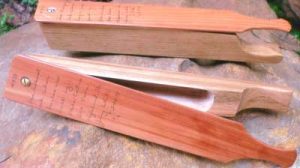
Dads Long Box
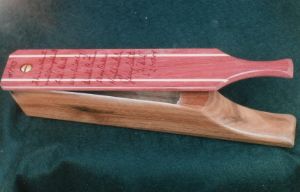
Dad’s Lil Long Box-Walnut & Pu
Some call makers not only build for a raucous, loud, locating type double note, but also a soft, discreet double note yelp. It is easy to see why a long box that possesses both of these qualities is a call for the owner to cherish and the call maker to demand and receive a substantial price for his efforts. Fortunately, even the basic, less expensive paddle boxes can raise enough cane to get a gobbler to sound off. You don’t have to spend a fortune to buy a good working long box, but if your objective is to build a collection of appreciating monetary value, expect to invest substantially from the start.
Unlike standard and single sided boxes, the long box body features a handle. The purpose of the handle is to make easier, the vertical-oriented operation of the call. Hunters, unfamiliar with the long box, are sometimes disappointed with the sound and performance because they attempt to run it in the same manner as a short box (standard box). Traditionally and with great effectiveness, long boxes are operated in the following manner. Based on right-handed usage, the box handle is lightly gripped in the left hand, and held vertically 8-12 inches from the callers face. The face of the left sideboard should be in front of the callers face. Handle can be gripped with thumb only toward the caller or between index and forefinger at first knuckle with exposed index finger and thumb toward the caller. A grip any higher then the point where the handle meets the box will result in pressure on the sides and affect the sound. This may not be a bad thing. Experiment with grip location and pressure on the sides, but in many cases the box has been tuned by the call maker, to deliver its optimum sound, by holding the handle only. The long box can reach its designed potential by letting the side boards vibrate, unhindered by pressure, to the friction of the paddle being passed across.
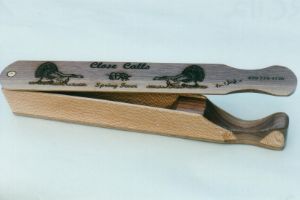
Quaker Boy Grave Digger Boat Paddle Box Call
Two ways to hold the paddle handle are: thumb on left side of handle with the tip of index finger on the right side (thumbnail will be facing caller), or between index finger and forefinger on last section of fingers between knuckle and tip (left side of index finger faces caller). In this described vertical hold of the paddle box, lid is brought back toward callers face, 2-3 inches from box center to paddle center, then stroked away from caller across the left blade of the box.
As in all box call usage the paddle remains in contact with the blade on both back and forward stroke. No sound is made as paddle is brought back toward caller. For the yelp, on the forward stroke start with the paddle center 2-3″ from the box center, as you begin this stroke, hold the paddle loosely and flat or exert a slight twisting pressure on the right side of the paddle. Exerting this pressure may vary Tone and pitch of the yelp. For excited cutting calls of a hen, hold the paddle and box as for the yelp but this time lift the paddle 1-2″ off the blade. Strike the left blade with a sharp, quick, combination downward and outward stroke. Long boxes excel at the cutting call. Many long boxes do not have a spring on the screw between paddle and box. This is to allow the caller more versatility in applying pressure on the paddle against the blade.
Some long boxes produce good turkey sounds by operating them flat and off the right blade, like a standard box call. This may work best for you. But consider this distinct advantage of using the long box in the vertical manner. Calls made are actually forced forward, like a shot arrow or a thrown ball, projecting them greater distances in a more directional manner.
First time users beware! If you have ordered a long box, it arrives in the mail, you open the box and run the call – expect it to NOT sound like a standard box call. It is often too much noise for inside. Take the long box to the back yard and follow the above suggested usage techniques. If the sound emitted is high pitched, shrill and nasty, and sounds like a yelp with a lot of static, you are on the right track. Remember the old boss hen – her tone of voice is not bashful in the least. She wants that boss gobbler to answer fast and come in running.
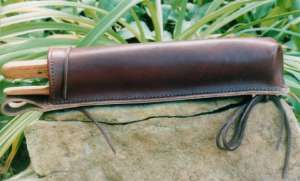
Eight Hooter Custom Leather Paddle Box
The preceding text is the sole thoughts and opinion of George Lozzi, Turkey call enthusiast and owner of MIDWEST Turkey Call Supply. For reprint or copy permission, please contact George at CustomerService@midwestturkeycall.com or call 573-824-5303. © 2005
